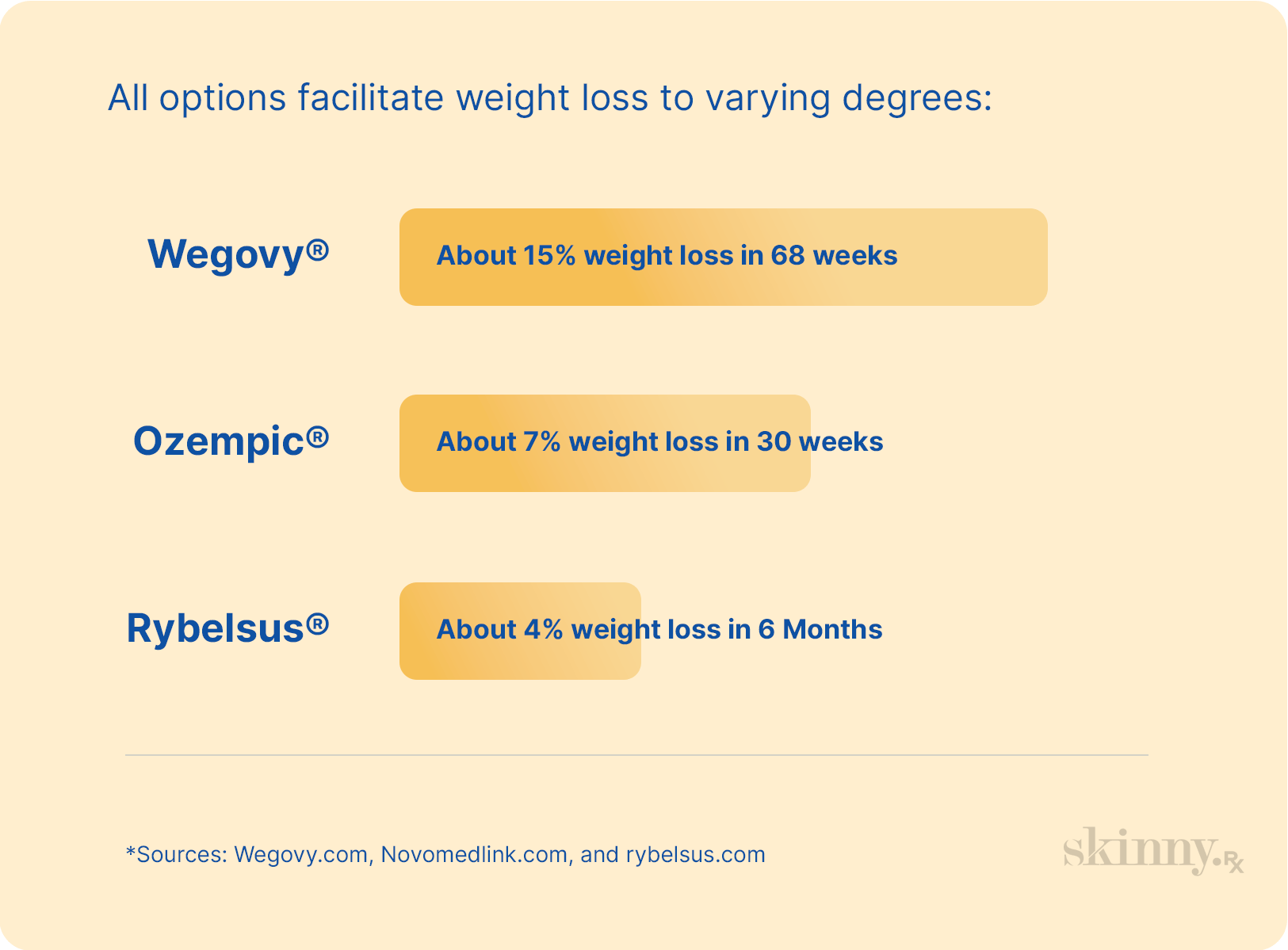
Key Takeaways
- Wegovy, Ozempic, Rybelsus, and compounded semaglutide all contain semaglutide but differ in FDA approval, intended use, and how they’re taken.
- Wegovy is the only option FDA-approved for weight loss, while Ozempic and Rybelsus are approved for type 2 diabetes; compounded semaglutide is not FDA-approved.
- Wegovy delivers the highest average weight loss, Ozempic offers added heart and kidney benefits for diabetics, and Rybelsus is a daily pill for those who prefer to avoid injections.
- Compounded semaglutide is more affordable but comes with greater safety risks and is rarely covered by insurance[1].
Weight loss medications have earned quite a reputation, and one of the most common types is semaglutide. This class of medication works by mimicking GLP-1, a naturally occurring hormone that regulates appetite and helps control blood sugar levels.
Currently, there are three semaglutide medications approved by the Food and Drug Administration (FDA): Wegovy, Ozempic, and Rybelsus. Each has different intended uses and comes with its own set of pros and cons. Throw in compounded semaglutide, and the options can be overwhelming. Learning the key differences between the four types makes it easier to decide which is right for you.
Wegovy vs Ozempic vs Rybelsus Breakdown
Wegovy
Wegovy is the only FDA-approved semaglutide for weight loss. That doesn’t mean the FDA recommends Wegovy for anyone trying to lose weight. Instead, it’s recommended for individuals who meet specific criteria: have a body mass index (BMI) ≥30 or ≥27 with one or more weight-related comorbidities, such as untreated high blood pressure or heart disease.
Wegovy is a once-weekly injection. The FDA recommends that medical practices train patients on how to self-inject Wegovy, though they also provide some general guidelines:
- Inspect each dose before injecting to make sure it’s colorless and clear.
- Administer the injection at the same time and day each week.
- Inject into the abdomen, upper arm, or thigh.
Ozempic
Ozempic is FDA-approved for those with type 2 diabetes, though it’s not FDA-approved for weight loss. Ozempic helps regulate blood sugar levels, especially when paired with a healthy diet and exercise. But Ozempic is not an insulin replacement, and it’s safe to take both at the same time if prescribed by a doctor.
Ozempic offers additional benefits for type 2 diabetics, including:
- A lower risk of cardiovascular events, such as a heart attack or stroke
- Decreased risk for end-stage kidney disease
- Reduced chance of cardiovascular-related deaths
- Weight loss
Like Wegovy, Ozempic is injected weekly, following the same general self-injection instructions. If taking Ozempic and insulin together, don’t mix the products. Administer each separately, though they can be injected into the same area of the body.
Rybelsus
For the needle adverse, a huge con to Ozempic and Wegovy is the weekly injections. Rybelsus, an oral tablet with semaglutide, offers an alternative. This pill is FDA-approved to improve blood sugar control for those with type 2 diabetes and offers similar benefits as Ozempic.
Patients take Rybelsus right after waking up, before eating anything, and with no more than four ounces of water. Once taken, wait at least 30 minutes before eating breakfast or drinking something other than water so that the pill can absorb properly in the stomach.
Compounded semaglutide
Compounded medications are a generic version of a drug but some ingredients and the amount of semaglutide is different.
Compounded medications may be prescribed when:
- A name-brand medication is too expensive based on an individual’s insurance and budget
- There’s a shortage of the name-brand version
- The name-brand option cannot meet health needs
- An individual is allergic to an inactive ingredient in the name-brand medication
Compounded medications are not FDA-approved, meaning the FDA hasn’t examined the effectiveness, quality, or safety of compounded semaglutide. As a result, not all compounded versions have the right concentration of semaglutide, increasing the risk of hospitalization due to a high dose.
To avoid adverse effects, purchase compounded medications from a licensed pharmacy. The FDA’s BeSafeRx campaign offers tips on how to find a licensed, safe pharmacy online.
Key Differences
FDA-Approved Uses
The first key difference between the four semaglutide options is FDA approval:
- Wegovy: Approved for weight loss (BMI ≥30 or ≥27 and a comorbidity)
- Ozempic: Approved for Type 2 diabetes
- Rybelsus: Approved for Type 2 diabetes
- Compounded semaglutide: Not FDA approved
Any option can be prescribed off-label for another reason (i.e., Ozempic may be prescribed off-label for weight loss), but the FDA only guarantees the drug’s effectiveness for approved reasons.
Dosage Forms & Frequency
Wegovy and Rybelsus come as a once-weekly injection. Patients self-inject or have a loved one inject them with the medication. Rybelsus is a daily pill, while compounded options can take the form of an injection or oral tablet.
With semaglutide, a medical provider will start a patient on an initiation dose, checking if the drug is tolerated. If tolerated, they’ll slowly increase the dosage until it is at a maintenance concentration, the recommended dose for most patients. The dosage timelines differ for Wegovy, Ozempic, and Rybelsus.
Wegovy
Start with 0.25 mg weekly for four weeks. If tolerated, work up to a maintenance dose (2.4 mg), ideally on the following timeline:
Ozempic
Start with 0.25 mg weekly for four weeks. If tolerated, increase to 0.5 mg weekly. If 0.5 mg is well-tolerated for at least four weeks, the dose may be increased to 1 mg or 2 mg weekly, though this isn’t always required.
Rybelsus
Start with 3 mg for 30 days. If tolerated, increase to 7 mg at the 30 day mark. After 60 days, the dose may be moved up to 14 mg, though this isn’t necessary if getting desired effects from 7 mg.
Clinical Efficacy Data
All options facilitate weight loss to varying degrees:
- Wegovy: About 15% weight loss in 68 weeks
- Ozempic: About 7% weight loss in 30 weeks
- Rybelsus: About 4% weight loss in 6 months
While Wegovy is better for weight loss, Rybelsus controls blood sugar best and Ozempic may best reduce the risk of heart disease for type 2 diabetics.
It’s more difficult to predict the clinical efficacy of compounded semaglutide, although participants in one 2025 study experienced 4.57% weight loss with a compounded version in three months.
These stats are impressive, but results vary. Plus, semaglutide’s success often boils down to three things: consistent use of semaglutide as instructed, a low-fat, low-calorie diet customized to the individual, and regular exercise.

Side Effect Comparison
In one study on semaglutide, one-third of participants experienced side effects. No matter the form (Rybelsus, Wegovy, or Ozempic), the most common side effects are the same:
- Stomach pain
- Yellow skin or eyes
- Fever
- Sweating
- Lightheadedness
- Anxiety
- Nausea
- Vomiting
- Constipation
- Diarrhea
- Faster heartbeat
- Shakiness or weakness
- Headaches
- Blurred vision
- Fatigue or drowsiness
More severe side effects include:
- Possible cancerous or noncancerous tumors in the thyroid
- Kidney problems, including possible kidney failure
- Severe allergic reactions where it’s difficult to breathe
- Higher risk of low blood pressure, which can be life-threatening if left untreated
Both Ozempic and Wegovy also increase the risk of gallbladder problems. Upper stomach pain, yellow skin or eyes, fever, and stool that’s clay colored are the three most common side effects of gallbladder complications. Rybelsus may cause inflammation in the pancreas, characterized by vomiting and upper stomach pain that refuses to go away.
If you’re experiencing any severe side effects, stop taking medication immediately and call emergency medical services.
Long-Term Safety Profiles
Semaglutide is still a relatively new medication with a long list of potential side effects. So, is it safe to take in the long run? In most cases, the answer is yes.
A 2024 study reported that semaglutide is safe for diverse patient populations and differing treatment durations. While the study did report a small number of adverse reactions, most patients tolerate semaglutide well and even experience health benefits, such as losing weight, a lower risk of cardiovascular-death, and improved blood sugar control.
Contraindications
Almost every prescription has contraindications, pre-existing conditions that disqualify someone from taking it. Since Rybelsus, Wegovy, and Ozempic belong to the semaglutide family, they share contraindications. Someone shouldn’t take semaglutide if they have a:
- Personal or family history of medullary thyroid carcinoma (MTC)
- Diagnosis of Multiple Endocrine Neoplasia Syndrome Type 2
- Established hypersensitivity to any form of semaglutide
- Allergy to any inactive ingredients in Rybelsus, Wegovy, or Ozempic
If trying to get pregnant or currently pregnant, semaglutide isn’t recommended. Any form of semaglutide in the two months before and during the pregnancy increases the risk of premature birth and low birth weight.
Cost and Insurance Coverage
There’s no denying that semaglutide can be expensive, especially if someone doesn’t have insurance. Here’s a full breakdown of how much each option costs:
In order for semaglutide to be covered, a healthcare provider must submit a request to the patient’s insurance. The provider details why semaglutide is medically necessary, the reason it’s prescribed, and any other treatments a patient has tried.
The insurance company then approves or rejects the claim. If rejected, an individual and their doctor can appeal, with insurance companies having 30 days to respond to most appeals. The Obesity Action Collective offers resources on how to appeal a denied insurance claim. That said, very few insurance companies will cover compounded semaglutide since it’s not FDA-approved.
Savings Programs
For those whose insurance doesn’t cover semaglutide, compounded medication is often the most viable choice since its list price is the most affordable. There’s also the Wegovy saving programs, where uninsured or underinsured individuals can get Wegovy directly from the manufacturer for as little as $499 a month. While Rybelsus and Ozempic are made by the same manufacturer, there isn’t a savings program for either.
Which One Is Right For You?
There is not a single “best” version of semaglutide. Instead, the four options suit different budgets, health conditions, and preferences. While it’s important to discuss options with a healthcare provider, who can then prescribe the best choice, here’s a few semaglutide superlatives to keep in mind.
Best For Weight Loss Only
The semaglutide with the most clinical evidence supporting weight loss is Wegovy. It’s FDA-approved for this purpose, and patients experience 15% weight loss in 68 weeks on average, compared to 4% in six months with Rybelsus and 7% in 30 weeks with Ozempic.
Best For Type 2 Diabetes
Ozempic is FDA-approved for type 2 diabetes and has the most clinical evidence to support its ability to reduce the risk of adverse cardiovascular events and end-stage kidney disease for people with type 2 diabetes.
Best For Needle-Phobic Patients
Ozempic and Wegovy must be self-injected into the thigh, upper arm, or stomach once a week. Needle-phobic patients may prefer Rybelsus, which is taken as an oral tablet, offering many of the same effects. Like Ozempic, it’s FDA-approved for type 2 diabetes.
Best For Budget-Conscious Patients
If someone is uninsured or their insurance won’t cover semaglutide, compounded semaglutide may be a good choice. It may also be recommended when someone is allergic to an inactive ingredient in Ozempic, Rybelsus, and/or Wegovy.
Switching Between Brands
Medically, it’s safe to switch between Ozempic, Rybelsus, Wegovy, and compounded options. Dosages may differ, making it important to consult a healthcare provider when changing.
While safe, it may cause some friction with insurance. If an insurance provider approves a patient for Ozempic, they’re not automatically approved for Rybelsus, compounded semaglutide, or Wegovy. When covered by insurance and looking to switch, make sure a doctor submits an authorization claim for the new medication before making it official.


 Medically Reviewed
Medically Reviewed
